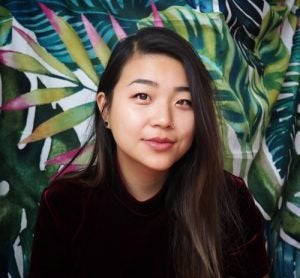 Science communicator Christine Liu was drawn to art at an early age. ”My parents saw my interest in art long before they saw my interest in science,” explains Liu, “So it was a very big surprise when I decided to become a scientist.” Liu, a Ph.D. candidate in neuroscience at the University of California Berkeley, now uses art to engage diverse audiences in science.
Science communicator Christine Liu was drawn to art at an early age. ”My parents saw my interest in art long before they saw my interest in science,” explains Liu, “So it was a very big surprise when I decided to become a scientist.” Liu, a Ph.D. candidate in neuroscience at the University of California Berkeley, now uses art to engage diverse audiences in science.
Liu’s interest in science communication began when she was an undergrad at the University of Oregon while studying biology and psychology. She found her science courses so fascinating that she felt compelled to share what she was learning with others. “Having the chance to take these fundamental science courses felt like I was handed secrets to the universe,” Liu states. Observing the inaccessibility of those “secrets” for many people, she used art to explain the fundamental science concepts in an accessible way.
Liu combined art and physics in a children’s book she wrote and illustrated, Kitty’s Morning Tea: Kinetic Theory of Matter for Kids, to communicate the complex concepts of kinetics in a way that children could understand and enjoy. With her success at communicating complex topics to young children, Liu saw the potential to reach marginalized audiences through targeted communication. As a daughter of immigrants, she understands the importance of inclusive science communication based on her own experiences. “It’s not about putting in more effort, but a more inclusive effort,” explains Liu, who works to identify the barriers in traditional science. “When you provide the resources and tools for people to recognize those barriers and enable them to share science where it is needed, everyone is empowered,” she says.
Liu uses a varied suite of tools to reach broader audiences including multiple social media platforms. “Each tool is different and if there is one that works best for a particular audience I will choose that,” she explains. One of those platforms is Instagram Reels, which she uses to engage people including strangers in conversations about science. She also employs art to communicate science topics through a variety of methods, including jewelry-making and illustrations for zines, do-it-yourself art booklets. Liu discovered that zines are an effective way to communicate science to counter culture, punk, and artist communities.
She demonstrated the effectiveness of zines as a science communication tool at Metcalf Institute’s 2018 Inclusive SciComm Symposium in her session, Novel Strategies for Bringing Science to Real People. Liu says the symposium was when she realized her hobby of integrating art and science made her a science communicator. “The symposium showed me that inclusive science communication should be something many scientists, educators, and practitioners, should be working to advance,” she states. “After the symposium, I made so many connections that have persisted and helped me continue my work,” reflects Liu. Two years later, she created graphics for Metcalf Institute’s comprehensive report on the state of science communication.
Liu’s work with Metcalf Institute also led to an invitation to participate in the Allied Media Conference, a convening of illustrators, visual artists, and arts collectives, to discuss her use of art in science communication. “I am really thankful to Metcalf for thinking of ways to link me to the science communication community,” she says.
Liu believes that the future of inclusive science communication includes walking alongside every audience and leveraging curiosity with empathy and interest. “Every person deserves to be able to ask questions and have their inquiries be taken seriously.”
Written by Hannah McDonald. She’s in her first year of a URI College of the Environment and Life Sciences (CELS) Communications Fellowship. The Fellowship was established in 2014 to help graduate students gain hands-on science communication experience by interviewing, gathering content for stories, and writing for the CELS website, social media, and newsletter.
read more alumni profiles
